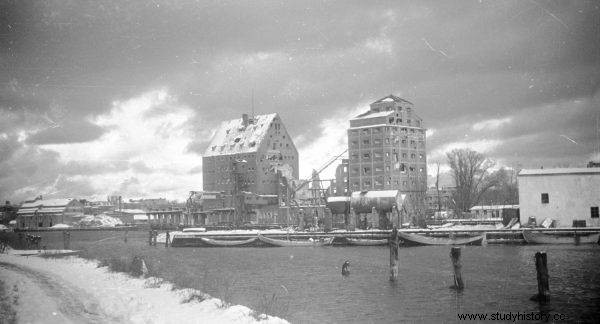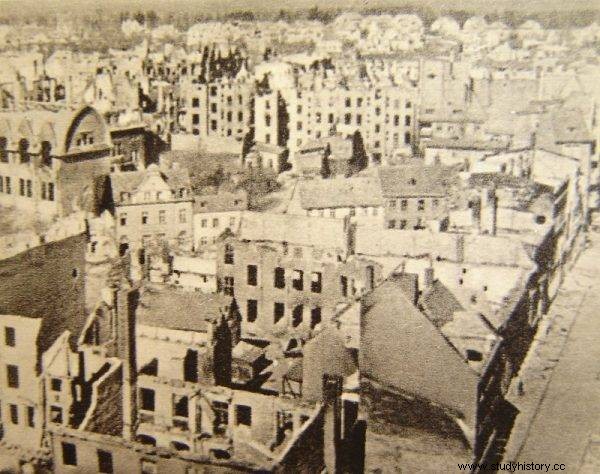The number of inhabitants of Kołobrzeg at the turn of February and March 1945 increased from 35,000 to even 85,000. The defense of Festung Kolberg was their only hope for rescue.
For the inhabitants of Koszalin, Kołobrzeg and Białogard poviats, an attempt to escape from the Red Army via the Odra River was unrealistic. The Kołobrzeg harbor became the last possibility of rescue. At the end of February, to get out of town, we had to fight for a place on the train . Only two trains a day departed towards Szczecin. The first passengers jumped into the carriages, even before the train reached the platform. Half the people stayed when he left. Families were often separated in this way, and children were lost to their mothers.
The snowy night of March 2/3, 1945 was filled with anxiety. There were various rumors among the inhabitants. Some said that there are already Russians in nearby Koszalin. There was waiting for a train at the station, but no one knew when or if one would leave at all. On the tracks there were freight depots overcrowded with people, which had been trying to leave for 24 hours. Probably the last train that left Kołobrzeg was shot at by Soviet tanks. Passengers (mainly women with children) hid under it and fled towards nearby buildings. Soon soldiers of the Red Army entered. They robbed the fugitives and raped the women.
The ordeal of the German inhabitants of Kołobrzeg began on March 4, when the Red Army approached the city. Due to the snowstorm, some residents decided to stay at home and wait out the fights. Those who managed to get out didn't get far. Johannes Voelker from Kołobrzeg, together with his wife, two sons and belongings placed on two handcarts, left the city just before the Red Army encircled it. His journey ended in Dźwirzyno, 12 km from Kołobrzeg, where the front caught up with them. Others also failed to escape from the Red Army.
Harbor Hell
Almost immediately ships with refugees began to leave the port . On March 4, the steamship Heluan went to sea, saving 1,500 people. People were taken by fishing boats. They reached Świnoujście, from where - after disembarking passengers - they set off on their way back to Kołobrzeg. Initially, mainly refugees from other regions of the Third Reich were trying to get on the ships. . The inhabitants of Kołobrzeg were discouraged by the thought of leaving their homes and by the memories of the disasters of the previously sunken "Wilhelm Gustloff" and the steamer "General Steuben" . The more so that the survivors of "General Steuben" ended up in Kołobrzeg, which only increased the fear of a sea escape. In the first days of the siege, some of the inhabitants had to be brought to the port by force, in order for the ships to set out fully loaded. The young woman already on board even forced her to take her to the city.

The relentless shelling of the port caused enormous casualties among civilians
As the situation of the besieged city worsened, more and more people flocked to the harbor. All the houses and cellars surrounding it were occupied by refugees awaiting rescue. Despite the continuous fire, when someone shouted:"You can see the ship!", Everyone ran out of their hiding places. Pushing, tramping and shoving into the water, they perished while waiting to be rescued.
The relentless shelling of the port caused enormous casualties among civilians who were overwhelmed by one thought - just to get on the ship. The abandoned harness horses, crazed with fear, fell into this mass of people. With each passing day, people felt more and more short of drinking water. It was taken from the port basin in which the corpses were swimming. One officer noted that:“The food is first class. Anyone can have as much chocolates, cigarettes, alcohol as they want. Preserved deli are located in the basement warehouses of hotels and guesthouses. And yet people would give a fortune for a glass of good drinking water. ”
Death and madness
Thousands of women and children waited for rescue in the cold weather and during storms by the coastal promenade, in the port, at the school in Budzim and the Christian Sanatorium Siloah. The fortress commander, in an attempt to control the chaos, formed a port patrol. His task was to ensure that mothers with children were evacuated in the first place and men over 65 years of age. Some of the men were sent back to join the Volkssturm. As a consequence, families were often separated. Many women refused to evacuate without their husbands and chose to stay in the fighting city. On March 6, it was decided that all men were to participate in the fighting.
There were all kinds of rumors among the inhabitants. The Nazi propaganda machine was still working. Civil radio stations and the press reported on the successes of the Wehrmacht. It was reported that 300 tanks were destroyed in the battles between Gryfino and Kołobrzeg. Such announcements raised hopes for a new Wunderwaffe . Sentient thinkers have tried to get out of their snares or have committed suicide. Desperate mothers killed their children and then themselves . Some people went crazy, like the elderly resident of the house on Nettelbeckstraße. He refused to be evacuated, telling the soldiers that he was waiting for his daughters who had "gone shopping". He did not notice what was happening around him. After each bombardment, he would take out his broom and sweep the yard clean. Eventually he went out to "bring his daughters from the merchant."

Kołobrzeg in 1945
Stalin's organs
Due to heavy fire, some ships left the port before being fully loaded with refugees. One of the Kołobrzeg's boats recalled embarkation as follows:“Friday night, around 2, in constant fire, we walked on all fours across the pier, passing the port granaries, between dead soldiers and horses, in snow and rain. In the fog, the sailors led us from the end of the pier onto the warship - together with the evacuated soldiers and railwaymen. "
Anna Krüger, who was driven out of the house by German soldiers on March 17, said:"Meanwhile a lot of incendiary projectiles were fired. The city was fired upon by five "Stalin's organs." In this hell, the remnants of our household - among them seventy-six-year-old Mrs. Elisabeth v. Schuckmann, and a few refugees - were going to the port, accompanied by the drugstore owner Paul Schunke. There, thousands were waiting for the evacuation, which could only be carried out at night . We had been standing for about two or three hours when the terrible shelling of the port began. People scattered like crazy. " In chaos, Krüger was separated from the elderly Mrs. von Schuckmann. Krüger got on the ferry. After some time, she found out that her companion had returned to town. She committed suicide by throwing herself from her apartment window.
The happiness of "Winrich von Kniprode"
Not everyone who got on the ships was saved. Each day, the port was under fire from the Soviet artillery. Some ships were sunk. For others, fate seemed to be favorable.
On March 8 the former warship "Winrich von Kniprode" with about a thousand refugees and wounded from Gdańsk arrived at the Kołobrzeg port . Here more passengers (about 3,000) were loaded onto it. Most of them suffered from seasickness due to the terrible weather. In addition, some of them suffered from dysentery. After only an hour of voyage, the holds ran out of coal and the ship was at the mercy of the Soviet air force and navy . He was incredibly lucky - he had never been bombed; as if he hadn't been noticed. Passengers suffered from hunger, but all finally reached Świnoujście.
The city on fire
An even worse ordeal awaited those who chose to stay in the city or failed to escape. Polish and Soviet soldiers who entered Kołobrzeg, initially, for safety reasons, threw grenades into every cellar they passed . Even after the fighting ended, the city was still on the front line. In addition, in Kołobrzeg there were rear troops that looted and looted anything of any value. Women were raped, men were arrested and often deported.

The local population was treated in the same way as in other Pomeranian cities - as cheap labor.
Fires broke out in the city every now and then - Red Army soldiers set fire to looted buildings. According to the memories of the first Polish president of the city, Stefan Lipicki, on April 24, Kołobrzeg was still on fire:
We arrived at the site at dusk. You could see Kołobrzeg from a distance, or actually only the great glow . After entering the outskirts of the city from Białogard, we were surrounded by buildings burning along the streets, the impression was amazing - the roar of the fire, the crackle of collapsing roofs and ceilings, clouds of smoke and sparks.
The local population was treated in the same way as in other Pomeranian cities - as cheap labor. The Germans were used to clear the city rubble and bury the dead (the Soviet headquarters did not take care of the bodies). Then they were displaced and Kolberg became the Polish Kołobrzeg.
